What Camera Lens Best For Wildlife Photography
Updated on February vii, 2020
If your goal is to capture animals in their natural surroundings, you will need a suitable lens to do the job. Telephoto zoom lenses are the best lenses for wildlife photography as they allow you to isolate details of the mural, shoot from a long distance, and avoid disturbing the animals. Telephoto lenses can be heavy and often need to exist mounted on a tripod in order to be used. Still, the extra effort is worth it, as the images you will bring back home cannot be captured with whatever other type of lens.
When shopping for wildlife photography lenses in that location are a number of features y'all should proceed in heed. Prototype stabilization is important when you lot shoot from a distance, as even the smallest vibration can cause the image to go blurry. Depression light operation follows, especially if you plan to shoot birds in a woods where trees stop the sunlight from entering.
In this article, nosotros take nerveless the ten best lenses for wildlife photography for various brands of mirrorless and DSLR cameras, accounting for cost range, focal length, and build quality.
For more of our pinnacle wild animals photography gear recommendations, cheque out the Best Budget Lenses for Wildlife Photography.
Quick Respond - The Best Lenses for Wildlife Photography
-
Sigma 70-300mm f/4-v.six DG APO
-
Sony FE 70-200mm f/2.viii GM OSS
-
Sony FE lxx-200mm f/2.8 GM OSS
-
Fujinon XF55-200mmF3.5-four.8 R LM OIS
-
Fujifilm XF 100-400mm R LM OIS WR
-
Tamron SP 150-600mm F/5-6.3 Di VC USD
-
Nikon AF-S FX NIKKOR 300mm f/ii.8G ED
Desire to larn more about a technical term? Check out our Features Explained section below.
Need buying advice? Take a expect at these Things to Consider.
Reviews - Best Wildlife Photography Lenses
Tamron 70-300 f/4.0-v.half dozen
Specs
- Aperture: f/iv-v.6
- Focal Length: 70-300mm
- Length: 4.6 inches
- Weight: 0.96 lb
- Mount: Nikon / Canon
Features
- Affordable Toll
- Meaty Blueprint For Increased Portability
- Macro Shooting Function To Shoot Pocket-size Subjects
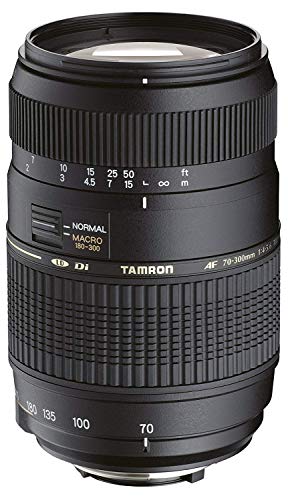
All-time FOR: Pocket-size-SCALE ANIMALS
Tamron 70-300mm f/4.0-5.6 lens is fabricated to complement Nikon cameras, especially DSLRs. The fact that it has an in-congenital motor makes its autofocus compatible with most cameras, enhancing their subject field tracking ability. The zoom range of this third-party lens gives enough flexibility for regular photography, as well as telephoto or macro shots. With such zoom capabilities comes chromatic distortions, which the lens takes care of past including a low-dispersion optical element.
Another advantage of the lens is its macro fashion that yields a magnification ratio of 1:ii, which is half the life-size of your discipline. This is especially useful for wildlife photographers taking an involvement in modest animals like mice or insects. And as y'all wander around looking for an interesting scene, the lens won't weigh you down. With a weight of just 16 ounces, the lens offers great features but still provides comfort.
Sigma 70-300mm f/4-5.6 DG APO
Specs
- Discontinuity: f/4-v.six
- Focal Length: 70-300mm
- Length: 4.8 inches
- Weight: one.21 lbs
- Mount: Nikon / Canon
Features
- Affordable Toll
- Big Zoom Range Allows You To Capture Wildlife Far In The Distance And Very Close Up
- Excellent Color Quality For Enhancing Natural Lighting
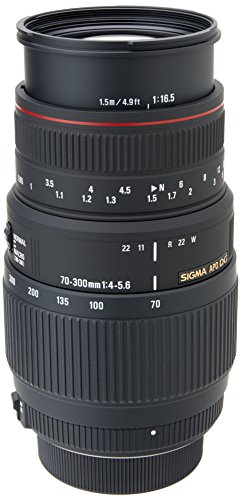
Best FOR: A Burst OF COLOR
Yet another third-party lens, the Sigma lxx-300mm f/4-5.half-dozen APO, is specifically oriented on color. This lens is termed APO because of its apochromatic optical elements. Their advantage over regular achromatic elements is color correction in different lighting.
What's more is that this lens has a large range of 70 to 300mm, roofing everything from wide-angle to telephoto shooting. You can zoom into the distance to capture a glorious wild fauna shot, as well as zoom upward close to an insect.
Moreover, the Sigma 70-300mm lens has a 9-bract diaphragm – the part that controls discontinuity – that gives yous control over depth of field. This is peculiarly useful for wildlife photography, so you tin vary the depth of the mural surrounding your subject. Plus, the lens has multiple layers of coating that protect your images from flare and chromatic distortions, as well as improve tonal contrast. Finally, it has a built-in autofocus motor, making information technology uniform with any camera.
Sony Atomic number 26 lxx-200mm f/2.eight GM OSS
Specs
- Discontinuity: f/two.8
- Focal Length: 70-200mm
- Length: 11.93 inches
- Weight: 4.91 lbs
- Mount: Sony
Features
- Dust And Wet Resistant For Robust Reliability
- High-Operation Optical Image Stabilization
- Mechanical Focus System For Precise Manual Focus
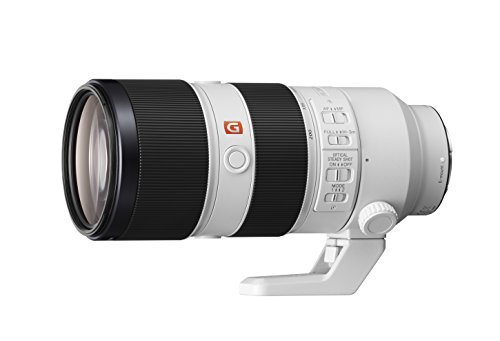
All-time FOR: FAST APERTURE
Sony FE 70-200mm f/2.eight GM OSS is part of the G Master serial, having superb optical design and other features. The FE 70-200mm has a wide aperture range, resulting in fast shutter speeds upwards to f/2.8. This lets yous capture moving subjects in great detail – a must for wildlife photography. This discontinuity range is also helpful in poorly-lit scenes and hand-held shots. As such, you take more versatility in when, where, and how you shoot.
The Sony f/2.viii GM OSS has another impressive characteristic. Harboring an 11-blade diaphragm, it gives you the ability to try your hand at different blurring effects, including bokeh, to enrich your wildlife shots. Be that a dynamic photo in move, or a still beast portrait, this lens will have lots to offer. Nonetheless, exist warned that compared to another Sony GM, this one has a smaller zoom range, so if you need telephoto, go on on reading!
Nikon lxxx-400mm VR
Specs
- Aperture: f/4.5-five.6D
- Focal Length: 80-400mm
- Length: 6.73 inches
- Weight: 2.95 lbs
- Mount: Nikon
Features
- Compact And Lightweight
- Produces Extra Sharp Images
- Vibration Reduction Organisation To Avoid Blur
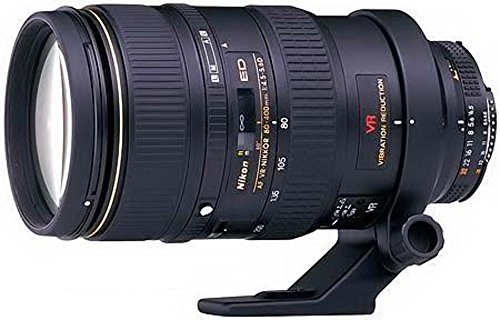
BEST FOR: VERSATILITY OF ZOOM
The Nikon fourscore-400mm VR lens has the largest zoom range, roofing everything from wide-angle to telephoto and macro shots. Naturally, this allows you to experiment with your fashion, so you tin can get as close as 5.7 feet to your subject and utilise the full zoom, as well as but zooming into the distance. You tin can utilise it with or without a tripod – any y'all are more comfortable with.
This Nikon lens farther has vibration reduction (VR) upwards to 4 shutter speed stops, and then your images look sharper. This is an asset especially for telephoto shooting, equally any small motion will result in annoying blur. Besides this, the VR corrects lighting in depression-lite conditions. Plus, dispersion elements right color distortions, and a Nano Crystal coating enhances colors in overexposed and backlit shots. Finally, a Silent Wave motor improves autofocus functioning, without making focusing sounds.
Canon EF 100-400mm IS II
Specs
- Aperture: f/4.5-5.6L
- Focal Length: 100-400mm
- Length: 7.6 inches
- Weight: 3.46 lbs
- Mount: Canon
Features
- Elegant Groundwork Blur
- Like shooting fish in a barrel To Use
- Fast And Silent Focusing System
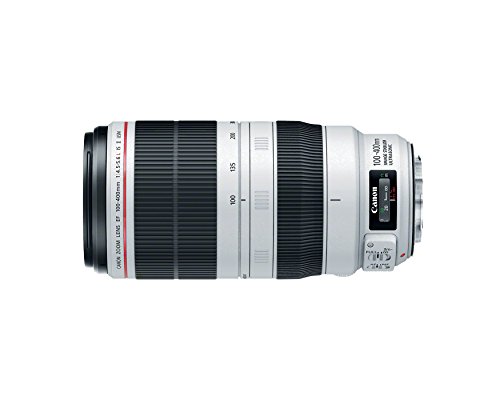
All-time FOR: OUTDOOR ADVENTURES
With its optical design, the Canon 100-400mm IS Ii lens minimizes colour distortions that always find a way into any photography. Especially, it gets rid of magenta and cyan aberrations at contrast points of zoomed-in images. Some other noteworthy feature is the lens' 4-stop stabilization. What this means is that it reduces photographic camera shake to make it appear as if the shutter speed is college. Wildlife photographers demand this, especially for telephoto shots.
And yet, for times when you exercise want a blurred background, Catechism 100-400mm has a 9-blade diaphragm that provides command over the depth of field and its qualities. With it, your subject volition stand out more than. To forestall unnecessary lens flare and move mistiness, in that location is an Air Sphere coating. Plus, this lens is weather condition-sealed and protected against fingerprint smudges, making it perfect for shooting outdoors in whatsoever weather.
Sony FE 70-200mm f/2.viii GM OSS
Specs
- Aperture: f/ii.8
- Focal Length: 70-200mm
- Length: 11.93 inches
- Weight: four.91 lbs
- Mount: Sony
Features
- Dust And Moisture Resistant For Robust Reliability
- High-Functioning Optical Image Stabilization
- Mechanical Focus System For Precise Manual Focus
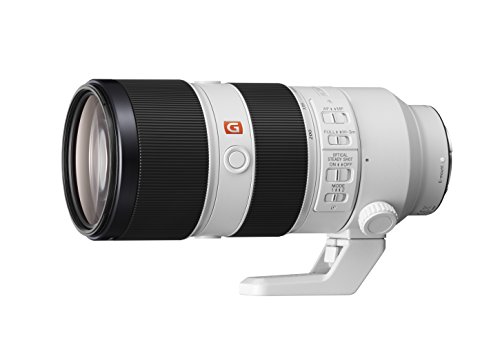
BEST FOR: FLEXIBILITY OF CONTROLS
One time over again, Sony's G Master line offers sharp resolution and great quality. And for wildlife photography, the lens has to rail moving subjects exceptionally well. Sony F4.v-5.6 GM OSS has several focus features to tackle that need. Mainly, it has a focus range limiter and various focus hold controls that provide you with more autofocus settings.
You lot can as well conform the stiffness of the zoom ring (basically, how much forcefulness you need to utilize to zoom in). This is helpful if you oftentimes find yourself switching between different zoom settings, or if you lot are on the become and need your zoom setting to stay every bit it is.
The lens is weather condition-sealed and compact, weighing only over 49 ounces. Thus, you don't have to worry about sudden weather changes, or that the lens volition add excessive bulk to your camera. The 100-400mm has an East-mount as well, and then you tin use it with DSLRs and total-frame mirrorless cameras.
Fujinon XF55-200mmF3.five-iv.viii R LM OIS
Specs
- Aperture: f/3.5-4.8
- Focal Length: 55-200mm
- Length: 4.65 inches
- Weight: ane.27 lbs
- Mount: Fujifilm
Features
- Sharp Images Across The Entire Zoom Range
- Vibration Reduction Organization To Minimize Gamble Of Mistiness
- Lightweight
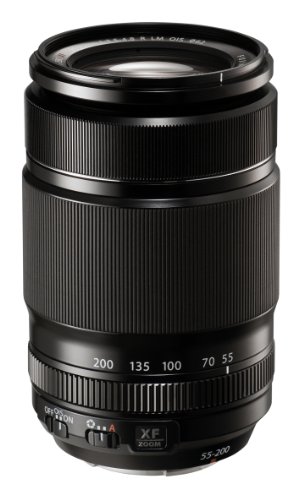
BEST FOR: COVERING THE Basics
If you're looking for a standard, no-frills wild animals photography camera, then the Fujifilm XF 55-200mm f/3.five-4.8 R LM OIS might exist for you. This lens' optical design works to eliminate chromatic distortions or inaccuracies that creep into zoomed-in shots. Information technology also provides sharp images and decent control over the depth of field.
A special Super EBC blanket further protects photos from lens flare or subtle blurring. As for the zoom range, information technology is not the biggest one, just information technology does provide the basics of wide-bending and telephoto shooting.
Naturally, this XF 55-200mm lens has a 4.5 stop vibration reduction and a silent autofocus system. The stabilization reduces camera shake to make your zoomed-in wild fauna shots equally sharp as possible. The linear autofocus motor works well with fast-moving subjects without making noise. And because you are a wildlife enthusiast, you will be spending some time in the wild and you might find the weight of this lens – just 20.5 ounces – helpful.
Fujifilm XF 100-400mm R LM OIS WR
Specs
- Aperture: f/iv.5-5.half-dozen
- Focal Length: 100-400mm
- Length: viii.29 inches
- Weight: 3 lbs
- Mount: Fujifilm
Features
- Fast And Precise Autofocus
- Weather-Sealed Construction To Guard Against Dust And Moisture
- Excellent Background Blur Effect
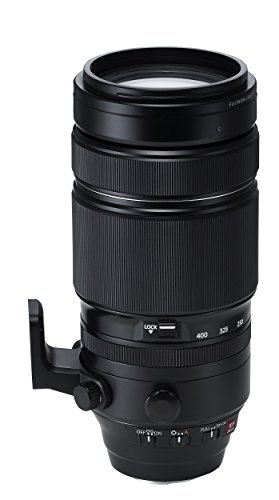
All-time FOR: THE FOCUSED HIKER
If the previous lens sounded corking, merely yous want to pace it up a notch, hither is the Fujifilm XF 100-400mm f/4.5-five.half-dozen R LM OIS WR. This lens offers twin linear motors, which is equal to an advanced autofocus that is ready to tackle fast moving wildlife subjects. It as well has an improved vibration reduction of v stops shutter speed stops, resulting in very sharp images.
However, we are non done with zoom and focus features but yet. A zoom lock will help y'all go on your zoom settings from accidentally shifting and so you can focus on other things. Fujifilm XF 100-400mm also has a focus limiter switch, and then that you can select how far or close-up you want to focus. This makes autofocus more efficient and accurate, especially with difficult-to-encounter wildlife subjects. The lens is equipped with thirteen different weather seals so you can confidently accept photos in any rain, storm, or even a blizzard.
Tamron SP 150-600mm F/v-6.3 Di VC USD
Specs
- Aperture: f/5-6.3
- Focal Length: 150-600mm
- Length: 10.2 inches
- Weight: 4.iv lbs
- Mount: Nikon
Features
- Captures Super Precipitous Images
- Precise Autofocus Arrangement
- Piece of cake To Mount On A Tripod
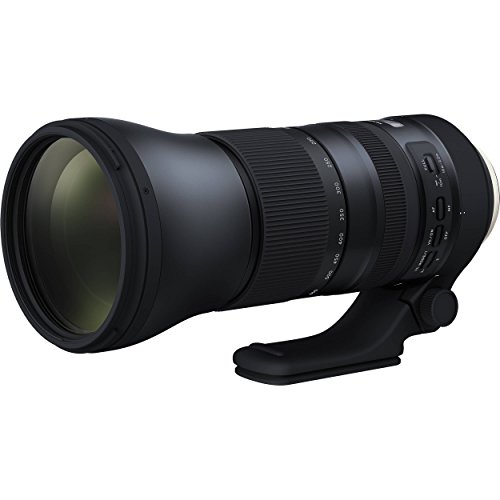
Best FOR: THE PHOTOGRAPHY SNIPER
Presenting the Tamron SP 150-600mm F/five-6.3 Di VC USD, it is crucial to note that this is the lens with the biggest super zoom on this list. Although it does not present a broad-angle option, these telephoto capabilities are ideal for wildlife photography, particularly from a distance.
Even so, you also need to keep in mind that this means weaker exposure controls. Another important specification is its epitome stabilization that works even with long shutter speeds, modest apertures, poorly-lit scenes, and mitt-held shooting.
Just similar other lenses hither, various coatings protect the lens from flare and color distortions. An Ultrasonic motor adds speed to and removes dissonance from autofocus, letting you concentrate on the framing and non on the sounds. Conveniently, Tamron Di VC is weather-sealed, so that'south 1 less thing to worry most. Considering information technology is a telephoto lens, yous would expect information technology to be beefy, but instead information technology is quite compact due to static optical elements, which saves space.
Nikon AF-S FX NIKKOR 300mm f/two.8G ED
Specs
- Discontinuity: f/ii.viii
- Focal Length: 300mm
- Length: 10.6 inches
- Weight: 6.39 lbs
- Mountain: Nikon
Features
- Exceptional Depression Light Performance
- Superior Sharpness And Realistic Colors
- Vibration Reduction System For Clear And Stable Shots
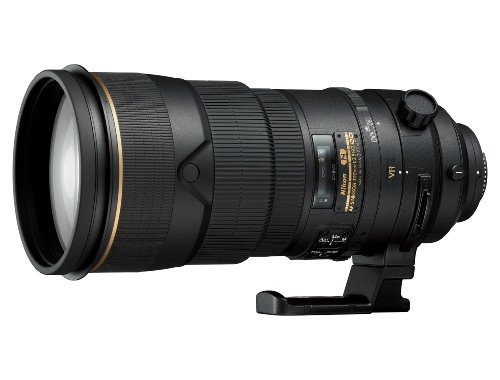
Best FOR: THE Prime PRO
Existence the just prime lens on this listing, the Nikon AF-S FX NIKKOR 300mm f/2.8G ED offers infrequent autofocus and aperture speeds suited perfectly for wild fauna photography. The f/ii.eight aperture guarantees you an easier time in low-light conditions, hand-held scenes, and experiments with shallow depths of field. Selective focus techniques also make themselves available to you in this lens.
In terms of the focal range, 300mm lets you lot shoot distant wild fauna subjects. But what's more than is that if the lens if mounted on DX model cameras, the focal length will get magnified to 450mm, extending your capabilities. Plus, the lens is uniform with several types of teleconverters, which are optional magnifying lenses that will farther increase the apparent focal length. Simply similar other lenses on this list, this one has a Silent Moving ridge Motor, vibration reduction, and a 9-blade diaphragm.
THINGS TO CONSIDER WHEN BUYING LENSES FOR Wild animals PHOTOGRAPHY
Prime OR ZOOM
Most wildlife photography lenses are telephoto lenses, and almost telephoto lenses are zoom lenses. This ways that past twisting a ring on your lens you can get closer to your subject by zooming in. The downside of zoom lenses is that considering of their versatility they tend to be less effective in depression light conditions. This is why professionals oft adopt prime number (or fixed) lenses. Prime number lenses don't let you zoom in, but offer better image quality in low light, which can make a huge difference in wildlife photography.
FOCAL LENGTH
All lenses on this list have a focal length that varies between 55 and 600 millimeters. This measure indicates from what distance a lens tin can frame a subject. Telephoto lenses have a focal length of 50mm or more – the college the number, the closer you can get to an animal without moving. Very long lenses are usually expensive and need a tripod to be used, but they also let you lot avoid disturbing the animals and allow y'all to stay at a safe distance if you lot are shooting wildlife that may be dangerous.
WEIGHT
Professional telephoto lenses are often very heavy, sometimes even heavier than the camera itself. There are many options bachelor for photographers who'd rather pack light. However, when it comes to telephoto lenses, size and weight is a adept indicator of quality. If you are only starting out, a mid-range lens will practice perfectly fine in most situations. One time you specialize in a detail kind of subject – whether that's insects, birds, fish, or big mammals – you may have to upgrade to something that is better suited for your needs. When thinking about weight, consider the fact that you'll often need to carry a sturdy tripod with you lot.
WEATHER SEALING
Weather sealing protects your equipment from dust, moisture, and light rainfall. While not essential, it is a convenient feature to look for if you lot plan to spend many hours in the outdoors or in place with high humidity.
FEATURES EXPLAINED
Prime LENS
A lens with a fixed focal length that ordinarily performs improve than a zoom lens in low calorie-free conditions.
ZOOM LENS
A lens that allows you to adjust the focal length by twisting a ring. With a zoom lens you can get closer to your subject without moving.
FOCAL LENGTH
The distance between the lens and sensor, indicated in millimeters. Focal length affects the framing angle, going from wider to narrower as the millimeters increase.
Aperture
The passage that lets the light attain the sensor and capture the image.
TELEPHOTO LENSES
A category of lenses designed to capture subjects from a distance.
READ More than
Source: https://www.theadventurejunkies.com/best-lens-for-wildlife-photography/
Posted by: lowewincert.blogspot.com


0 Response to "What Camera Lens Best For Wildlife Photography"
Post a Comment